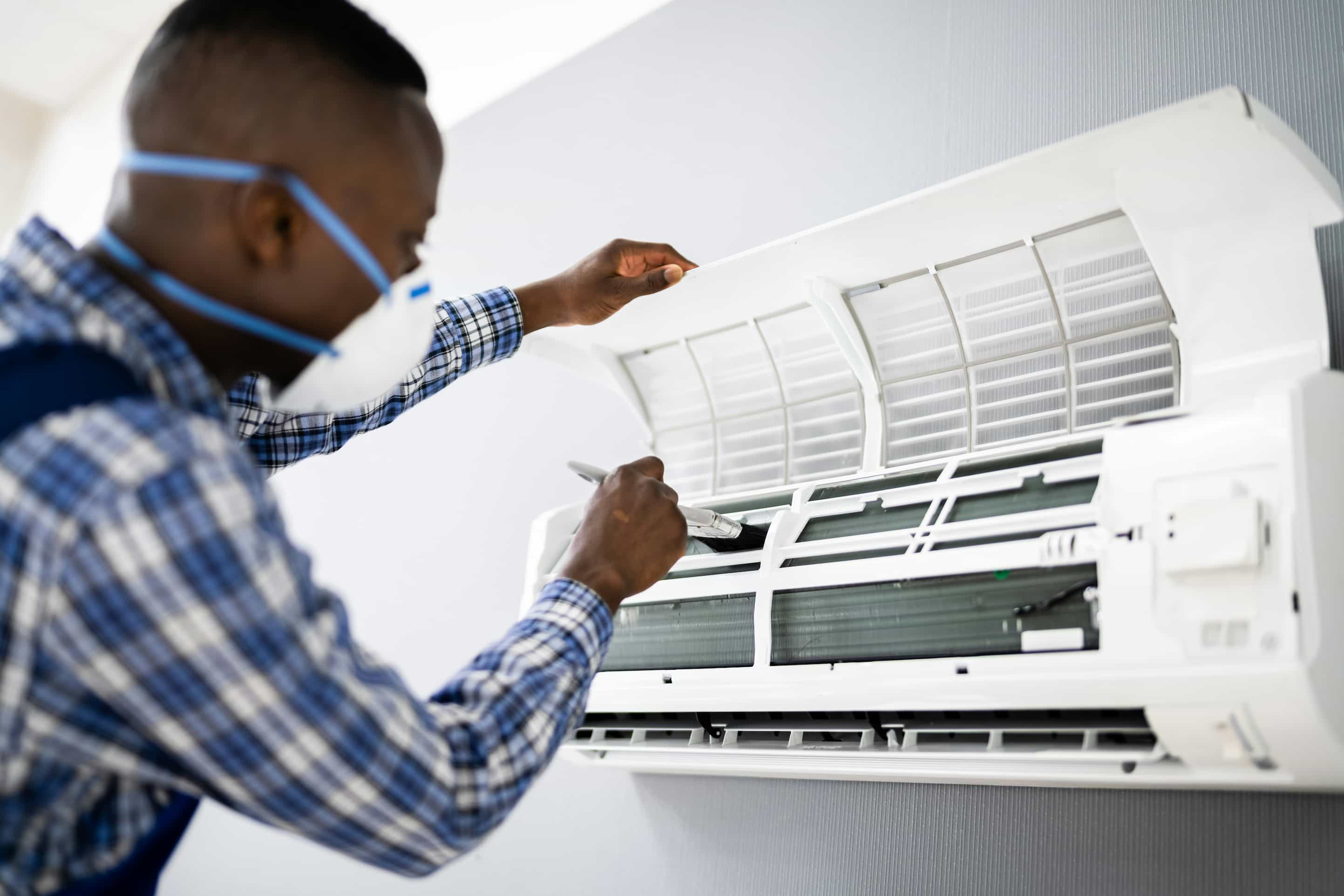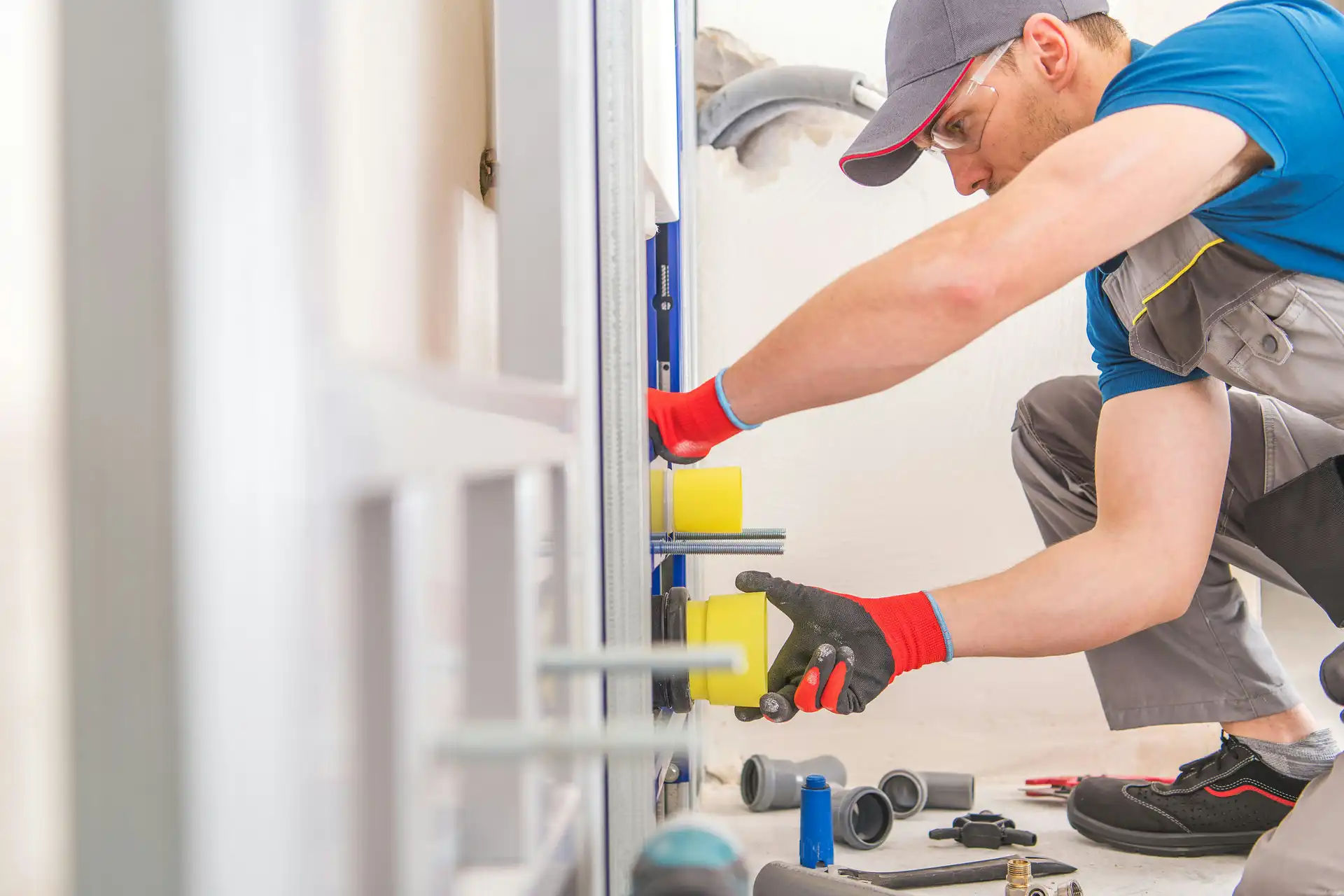Most HVAC companies rely on referrals and repeat customers—but when homeowners search online, your next job could come from Google.
HVAC SEO (search engine optimization) helps your business appear when people in your area search for heating or cooling help. The right approach can bring in steady leads without paying for every click.
This guide shares 10 HVAC SEO strategies designed for local service businesses. Each one is simple enough to start today and powerful enough to make a lasting impact on your visibility and calls.
1. Organize Your Website So Customers Find What They Need Fast
A clean, well-organized website makes it easy for customers and Google to understand what you offer.
When someone searches for “furnace repair near me,” Google looks for pages that clearly match that service. If your website lumps everything together on one “Services” page, you’re harder to find.
Instead, create separate pages for each major service you offer: AC repair, furnace installation, maintenance, duct cleaning, and so on.
Make navigation simple. Use a clear menu, like Home → Services → AC Repair, and include your phone number or “Book Service” button at the top of every page. Avoid long dropdowns or hidden pages.
Finally, double-check that your site works on both desktop and mobile devices. Most homeowners search from their phones, so they should be able to find what they need in one tap.
2. Find the Right Local Keywords
Targeting the right keywords ensures your site shows up for the people most likely to call.
Start by thinking like a customer. What would you type into Google if your heater stopped working? Likely something like “emergency furnace repair Denver” or “AC tune-up near me.” These phrases are your keywords—the search terms you want to appear for.
Use keyword research tools like Semrush or Ahrefs or simply type phrases into Google and check the “People Also Ask” section. That shows what real homeowners search for. Focus on service + city combinations (like “AC repair Orlando”) and urgent intent terms (“same-day,” “24-hour,” “near me”).
Use each keyword naturally in your page title, main heading, and first paragraph. Avoid forcing it too often—Google is smarter than that. The goal is to write like you talk when a customer calls and asks what you do.
3. Build Great Service Pages That Convert
Your service pages are where searches turn into calls. Each page should clearly explain what you offer and make it easy to book.
Include the following on every service page:
- What’s included: Describe the service in plain terms (“We repair all AC brands and replace worn parts on the same visit”).
- Common problems: List symptoms homeowners recognize, like “warm air from vents” or “furnace short cycling.”
- Why choose you: Highlight warranties, same-day service, or financing options.
- Proof: Add reviews or testimonials from real customers.
- FAQ section: Answer questions you often hear on the phone.
Keep design clean and trust-focused. Use photos of your team and branded trucks—not stock images. Add your phone number in multiple spots.
By organizing your site this way, you make it easier for Google to match your service pages to the exact terms people search for.
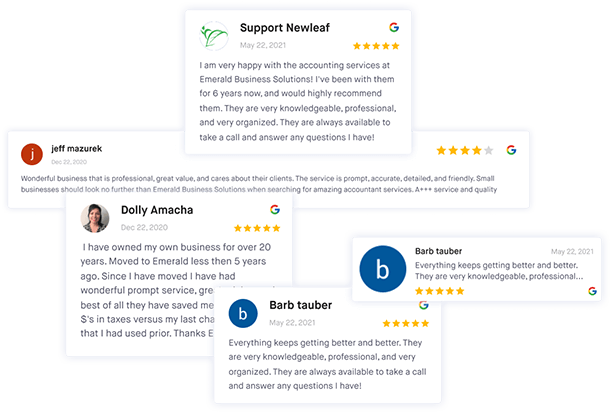
Improve your online reputation
Use ReviewsOnMyWebsite to manage and improve your HVAC business's online reputation with ease.
4. Create City Pages for Every Area You Serve
If you serve multiple towns, each deserves its own page. City pages help you rank for “service + city” searches while proving to Google that you truly work in those areas.
Write short, focused pages that mention local details homeowners recognize. For example: “We’ve been helping homeowners in South Denver stay warm through long winters.” Include a map, your office or service area, and a few photos of your technicians working locally.
Make sure each city page links back to your main service pages (like AC repair or furnace installation). This structure connects everything and helps you show up for both local and service-based searches.
5. Optimize Your Google Business Profile
Your Google Business Profile is the box that appears in Google Maps and the “3-pack” above normal search results. It’s often the first thing homeowners see—so treat it like a sales page.
Complete every field: business name, address, phone, website, hours, and service area. Choose the most accurate category (e.g., “HVAC contractor” instead of “general contractor”). Add at least 10 high-quality photos—your team, equipment, and real jobs.
Post updates weekly with tips or seasonal offers. Enable messaging and set an automatic reply so customers get a quick response.
Most importantly, collect reviews consistently. According to the State of Online Reviews report, 86.2% of consumers use Google to look up reviews of businesses. That means your Google profile isn’t optional—it’s where trust starts.
Keep your details consistent across the web (Google, Yelp, Facebook). Even small differences in your name or phone number can hurt rankings.
6. Collect and Showcase Customer Reviews
Customer reviews are the heartbeat of HVAC SEO. They influence both how high you rank on Google and how much homeowners trust you once they find you.
According to our research, 92.5% of buyers read an online review in the past year, and more than 78% won’t consider a business rated under 4 stars.
Reviews aren’t just social proof—they’re one of the strongest signals Google uses to decide which businesses appear at the top of local search results.
Ask for Reviews Automatically
Don’t wait for customers to remember on their own. After each completed job, send a polite follow-up email or text message thanking them and asking for feedback.
Include a direct link to your Google profile or main review page to make the process quick and easy. The more convenient you make it, the more reviews you’ll get over time.
Pro tip: You can use ReviewsOnMyWebsite to send email and SMS review requests to customers automatically.
Respond Quickly and Professionally
Replying to reviews shows you care about customer satisfaction. Even short responses like “Thank you for trusting us with your repair” can go a long way. When you receive a negative review, address it calmly and explain how you plan to make things right.
A thoughtful response builds credibility—78.3% of buyers say seeing a respectful reply makes them more likely to trust a business.
With ReviewsOnMyWebsite’s review feed, you can read and respond to all your customer reviews from one place. And use the AI-powered response feature to generate personalized replies in seconds.
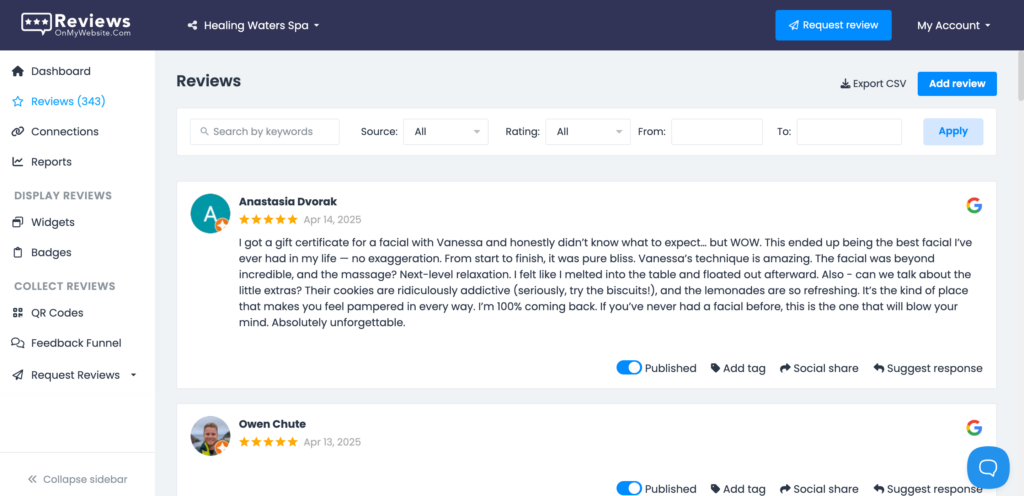
Showcase Your Best Feedback
Feature your top reviews on key pages of your website, especially your homepage and service pages. This is easy to do with ReviewsOnMyWebsite’s customizable review widget.
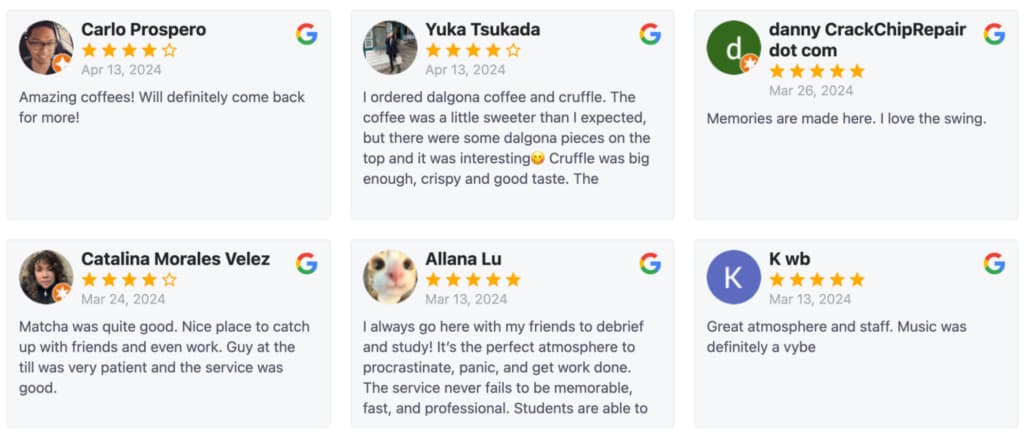
Screenshots or short text excerpts add trust without requiring extra design work. You can also share standout reviews on social media to show potential customers real experiences from homeowners in their area.
Keeping reviews visible helps new visitors feel confident reaching out.
Positive reviews not only attract more leads—they also remind Google that your business is active, responsive, and trusted locally. Over time, that steady flow of feedback turns into higher rankings and more booked jobs.

Improve your online reputation
Use ReviewsOnMyWebsite to manage and improve your HVAC business's online reputation with ease.
7. Write Helpful Blog Posts That Attract Homeowners
Blog content keeps your site fresh and answers common homeowner questions. Think of it as digital word-of-mouth.
Write short guides to problems your customers often describe on the phone. Posts like “Why is my AC blowing warm air?” or “How often should I change my furnace filter?” help you capture early-stage searches and position your company as an expert.
At the end of each article, link back to your related service page with a simple call-to-action like “If your AC still isn’t cooling, schedule a service visit today.”
Plan your content around the seasons. Publish cooling-focused posts in spring and heating-focused ones in fall. Regular updates also matter—35% of small businesses update their website monthly, which helps them maintain stronger online visibility.
Write naturally, using the same words customers use when calling. That’s the foundation of strong SEO for HVAC companies.
8. Make Your Site Fast and Mobile-Friendly
A slow or hard-to-use website drives potential customers away before they ever call—and Google notices that behavior.
When visitors leave quickly because your site takes too long to load or doesn’t work well on phones, Google treats it as a sign that the page isn’t providing a good experience. Faster, mobile-friendly sites tend to rank higher and convert more visitors into real calls.
Check your website using Google’s free PageSpeed Insights tool. It shows how quickly your pages load and whether your layout is mobile-friendly. Aim for a loading time under three seconds and a smooth experience across all devices.
To speed things up:
- Compress photos without losing quality: Large image files slow your site down, especially on mobile data connections. Use modern formats like WebP or online compression tools to keep images crisp but lightweight.
- Limit animations or sliders that slow down mobile pages: Flashy transitions or large banners may look nice on desktop but often frustrate mobile users. Simplifying them reduces file size and helps pages load faster.
- Keep the design simple and uncluttered: Avoid pop-ups, overlapping banners, or unnecessary widgets that distract from your phone number or booking form. A clean layout helps customers focus on taking action.
- Add click-to-call buttons for mobile visitors: Many people searching for HVAC services are in a hurry—make it effortless for them to tap and call you directly. Placing this button in your header or near CTAs can significantly increase conversions.
Even small technical improvements have a big impact. A site that loads quickly and works seamlessly on mobile devices keeps visitors engaged, reduces bounce rates, and tells Google your business deserves to appear higher in local search results.
9. Earn Links Through Local Partnerships
Backlinks—links from other websites that point to yours—are one of the strongest signals Google uses to decide which businesses deserve to rank higher.
When trustworthy local sites link to your HVAC business, it tells Google that your company is established, reputable, and active in the community. These local endorsements boost your authority and help your pages appear higher in search results.
You don’t need an expensive PR campaign or a marketing agency to build links. Simple community involvement and professional partnerships can naturally create the right opportunities.
Here are a few ways to build backlinks for your HVAC website:
- Join your Chamber of Commerce: Most chambers list members on their websites and include a link to each business. This not only helps your SEO but also puts your name in front of homeowners and business owners in your service area.
- Sponsor local events or youth teams: Community events and sports teams often post sponsor logos and links on their event pages or social media. This gives you both online visibility and real-world recognition.
- Collaborate with nearby businesses: Partner with plumbers, electricians, or home-service providers to offer joint promotions or seasonal giveaways. Each partner can mention and link to the other, creating relevant backlinks that strengthen both businesses’ SEO.
- Reach out to manufacturers or distributors: If you install or repair certain HVAC brands, ask to be listed as an authorized dealer or preferred service provider on their websites.
High-quality backlinks from relevant local sites are worth far more than dozens of random ones from unrelated blogs. Over time, consistent community partnerships build both your reputation and your rankings, helping your business stand out in local search results.
10. Track What’s Working (And What Isn’t)
SEO isn’t just about traffic—it’s about getting more calls and booked jobs.
Set up Google Analytics and Google Search Console to monitor which pages bring visitors and which keywords they use. Check your call logs and form submissions each month to see which services drive the most leads.
If your “AC repair” page brings 60% of calls, double down on similar topics. If a city page gets traffic but no calls, adjust the copy to include clearer CTAs or more local proof.
Treat your website like a living asset—review results quarterly and keep improving what works.
Stay Ahead With Emerging Trends
Search is always evolving, but you don’t need to chase every new trend. Focus on consistency and clarity.
Ask your web developer to include structured data—a type of code that helps Google understand your content (like services, hours, and reviews). This can improve how your pages appear in search results, especially when people use voice assistants.
Keep an eye on features like “AI Overviews,” which summarize answers directly on Google. If your content includes short, accurate explanations, it’s more likely to be featured.
Above all, stay active online. Post fresh photos, collect reviews, and refresh your most important pages a few times a year. Steady effort always outperforms quick fixes or gimmicks.
Frequently Asked Questions About HVAC SEO
What Is HVAC SEO?
HVAC Search Engine Optimization (SEO) is the process of improving your website and online presence so customers can find you when they search for heating or cooling help nearby.
It includes creating service and city pages, collecting reviews, and keeping your Google Business Profile updated.
Why Should HVAC Dealers Invest in Local SEO?
Local SEO helps you appear in Google Maps and top search results when homeowners in your area need service.
It boosts calls, improves visibility, and builds trust through consistent reviews—all without relying only on paid ads.
How Do I Improve SEO for an HVAC Business?
Focus on the basics: build pages for each service and city, add helpful content, and ask every satisfied customer for a review.
Update your Google Business Profile regularly, track which pages bring calls, and make small improvements each month.
How Long Does HVAC SEO Take to Work?
Most HVAC businesses start seeing results in about three to six months, depending on competition and consistency.
Google needs time to crawl your pages and build trust, but steady progress compounds over time.
What Are the Most Effective HVAC SEO Strategies?
The most effective HVAC SEO strategies include optimizing your Google Business Profile, collecting reviews, writing seasonal blog posts, and earning links from local partners.
Together, these build authority and help you rank higher in both local and organic results.
Keep Your SEO Running Year-Round
SEO isn’t a one-time project—it’s maintenance for your online presence. Just as you’d recommend seasonal tune-ups for an HVAC system, schedule quarterly updates for your website and Google profile.
Check that your contact details, photos, and reviews are current. Refresh pages before each season, and keep asking for customer feedback.
By maintaining your website and reputation year-round, you’ll stay visible, trusted, and fully booked—no matter the weather.
